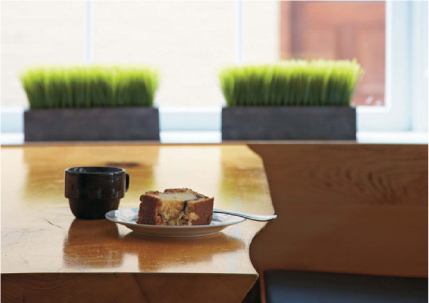
I no longer vacation like a normal person. Or, rather, I no longer plan vacations like a normal person. Now, when cobbling together and researching the traditional parts of a holiday (destination, arrival time, hotel, and length of stay), I also include at least one dessert or pastry excursion of note. This complicates matters for both my traveling companions and myself. Whereas before, a simple ski vacation included the basic elements of planning, I now add a layer of complexity that most of my friends would rather skip. In addition to choosing the mountain, the condo, and the best month to ski, I might also insist that we spend a day off-slope in search of a much-written-up, much-blogged-about creamy bourbon milkshake. The kind made with homemade vanilla bean ice cream, homemade butterscotch sauce, and top-shelf bourbon and blended at the same location by the same family for many, many years.
Early on, I referred to my dessert jaunts as “research.” I would tell myself (and my very tired and very full traveling companions) that I needed to “test” every chocolate chip cookie, every brownie, all manner of cakes and cupcakes, and every type of breakfast pastry to bring a deeper understanding to my development work at Baked or on the Baked books or for possible future concepts. Truth is, I would be eating my way through the United States and beyond, regardless of my occupation. It is my obsession and compulsion.
People often ask me if I ever tire of eating brownies (a signature Baked product). Absolutely not. What about chocolate chip cookies—don’t I want to take a break from chocolate chip cookies? Never. I enjoy finding the subtle differences from bakery to bakery and state to state. I want to know why a certain bakery in North Carolina always makes a crunchy chocolate chip with classic, tiny chips, and another bakery in Oregon always makes chewy ones with large chunks of chocolate. Is the disparity regional? Did the cookie in North Carolina originate from a hand-me-down heirloom recipe? Is the Oregon cookie an amalgam, a collaboration by a series of pastry chefs who rotated in and out the bakery door?
My dessert “research” is neither conventional nor scientific. The format is loose, and the results are beside the point. I enjoy what I do, and I will always choose Pierre Hermé over Mona Lisa. My worldview is formed by desserts and the people who make them, and my true satisfaction is derived from finding pockets of regionalism in an increasingly homogenous America.
There are obvious regional dessert specialties. The black and white cookie is nothing short of a phenomenon in and around New York City, while remaining distinctly off the radar in much of the rest of the country. Banana cream pie is a staple of the Los Angeles area restaurant and bakery circuit, yet it makes only brief and lackluster appearances elsewhere. Booze, especially the likes of Kentucky bourbon and Tennessee rye, is prominent in Southern desserts. Local fruits and produce are often directly tied to a regional specialty (i.e., blueberries in Maine, peaches in Atlanta). These observations are interesting, but it is the lesser-known regional subtleties that make my head explode. Dig a little deeper and unearth the treasures.
During Renato’s and my travels for various food-related research (a great benefit to owning a bakery and writing a cookbook), we met people who introduced us to favorite desserts that had been passed down through generations and at church suppers and small town gatherings. These recipes, carefully archived, are perhaps hyper-regional. These are recipes that are typically neatly handwritten on brittle, yellowing paper and tucked away in Grandma’s favorite cookbooks. An anomaly in a digital world.
We are always honored when people share these recipes with us (even, surprisingly, the Jell-O pretzel salad), and we are happy to share in return. It’s an “I’ll show you mine if you show me yours” scenario that has been deeply influential in our American baking repertoire, and we work daily to re-create or restore these truly great baking principles. Give us your vintage recipes, and we’ll—ever so lovingly—turn them on their head.
Another subset of American desserts that Renato and I pursue with glee could be classified as Abandoned Desserts. Boston cream pie, Mississippi mud, all things grasshopper, and their equivalents are desserts that never quite endured like the mainstays of American baking: chocolate chip cookies, apple pie, and brownies. The reasons for their gradual decline are varied, though still explainable.
Desserts, like fashion, are highly influenced by cycles and trends. If you were afloat in a sea of lava cake (aka molten chocolate cake) during the nineties, you were not alone. The dessert was on every restaurant menu (regardless of cuisine and price point) throughout the decade. As of this writing, spiking desserts with bacon is de rigueur. These fashions are part of a natural cycle. Lava cake will slowly fade into misty, dew-covered nostalgia, and bacon-flavored chocolate will become a fleeting trend, like parachute pants. When Renato and I dig through our pile of neglected desserts, we like to focus on investigating those beauties that lived through a few heady trend cycles and then were unjustly tossed to the gutter, like grasshopper pie.
We also look for baked goods that almost achieved classic status, like chiffon cake. For some reason, these desserts never quite reached their potential, and we place the blame squarely on the terrible versions people have encountered. After all, eating a substandard chiffon cake is like eating a kitchen sponge and sawdust sandwich.
Regardless, the Abandoned Desserts are something of a preoccupation of ours. We feel that it is our duty to provide some support to these old friends.
This book, Baked Explorations, is a tribute to beloved American desserts—treats and baked goods that are regional gems, fading beauties, or family secrets. It is a compilation of some of the more interesting items we found in our travels.
Renato and I set about looking for the roadways and history to all things sweet and realized that there is no direct route. Most recipes we found had been altered and tweaked by so many hands that one person’s simple chocolate cake recipe was completely different from the next-door neighbor’s, not to mention the recipe from the person two states over.
In some instances, we left recipes virtually unchanged from the version we were given. In other cases we performed a Baked makeover. This is not a compendium, nor a voluminous history of baked goods. Think of it as an easygoing road trip with stop-offs at the quirky and unusual monuments. Of course we included a few Baked customer favorites as well.
I hope you enjoy making and eating every recipe, and we encourage you to share a few with us.

